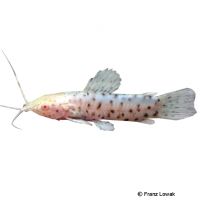Spotted Hoplo Albino (Megalechis thoracata)
| Spotted Hoplo Albino Megalechis thoracata | |
|---|---|
| Name | Spotted Hoplo Albino |
| Name Lat. | Megalechis thoracata |
| Synonym | Callichthys thoracatus |
| Family | Armoured Catfishes |
| Family lat. | Callichthyidae |
| Order | Catfishes |
| Order lat. | Siluriformes |
| Origin | South America |
| Habitat | Rivers, oxbow lakes |
| Diet | Omnivore |
| pH | 6.0-8.0 |
| Behavior | Peaceful |
| Keeping | Group |
| Care Level | Easy |
| Reproduction | Bubble nest builder |
| Breeding | Moderately difficult |
| Life Span | 4-8 years |
| Protection | No |
| Metric Units | |
| Size | 13 cm |
| Temperature | 18-28 °C |
| Hardness | 10-20 °dH |
| Aquarium | ~ 200 l |
| US Units | |
| Size | 5" |
| Temperature | 64-82 °F |
| Hardness | 178-356 ppm |
| Aquarium | ~ 50 gal |
Distribution and habitat
Painted callus catfish albino are widely distributed in the north of South America. They often live in schools in stagnant or slow-flowing waters, where they stay in shallow water with dense vegetation and sandy, silty bottoms covered with branches and fallen leaves.
Maintenance
The aquarium should have dense planting with shady hiding places (stones, roots). In order not to injure their barbels (serve for orientation and foraging), a soft, sandy substrate is ideal, which should be covered with some mulm and foliage (e.g. sea almond leaves).
No ammonia, ammonium and nitrite should be detectable, the nitrate value should not exceed 100 mg/l. To ensure the water quality and oxygen content, a filter and heater adapted to the aquarium size is required, as well as lighting for the species-appropriate day-night rhythm of the animals.
Diet
The food supply consists of live, frozen and dry food. For a balanced diet, feed once a day with a high-quality sinking dry food for catfish (granules, pellets, chips, tablets) as well as cyclops, daphnia, artemia, mysis, tubifex or mosquito larvae (live or frozen). In addition, occasionally some vegetable food, such as algae leaves or dry food with vegetable components (e.g. spirulina, kelp).
Only feed as much as is eaten within a few minutes. A regular and varied diet promotes health and increases resistance.
Behaviour and compatibility
They are calm and peaceful fish that should be kept in a group. A socialization with small fish like barbs or tetras, but also with larger cichlids is well possible.
Basically, only compatible fish species with similar demands on water conditions and water temperature should be socialized.
Sex dimorphism
In males, the first pectoral fin ray is distinctly broadened and colored yellow-orange during spawning. Males have a bluish-purple underside of the abdomen during the spawning season, which is white in females.
Reproduction and breeding
Involving floating plants, the male builds a large foam nest on the water surface. During mating (T-position), the eggs enter a pocket formed by the ventral fins of the female and are deposited in the foam nest after fertilization. This process is repeated a few times. The male takes over brood care and vigorously defends the nest. The larvae hatch after about 2-3 days and swim freely after 3-4 days. Fry must be fed several times a day with special rearing food (dust food, Artemia nauplii). In community tanks breeding is hardly possible, because the spawn is easy prey.
Important
They also have intestinal respiration to survive in oxygen-poor waters and sometimes come to the water surface for air even in oxygen-rich water. Foliage (sea almond, oak, etc.) enriches the water with humic substances, naturally lowers pH, and is a valuable secondary food source. When fishing, use the finest mesh nets possible to avoid snagging the hard rays of the pectoral fins, which can cause painful puncture wounds when touched. The well-being of the fish should be checked regularly. Temperature should be checked daily, pH, hardness and nitrate levels at least every 14 days. Regular partial water changes are recommended, even when contaminant levels have not yet reached the upper limit. Sudden changes in water quality should be avoided. Newly introduced fish must be accustomed slowly to the water in the aquarium. Further literature can be found in your pet store.
References
Text: petdata; Image: Franz Lowak
Source: BMELV (1998): Tierschutzgutachten - Haltung von Zierfischen (Süßwasser); RIEHL & BAENSCH (2006): Aquarien Atlas Bd. 1, Mergus Verlag; ENGELMANN (2005): Zootierhaltung - Tiere in menschlicher Obhut: Fische, Verlag Harri Deutsch
- Gemäß § 21 Abs. 5 Tierschutzgesetz idgF
